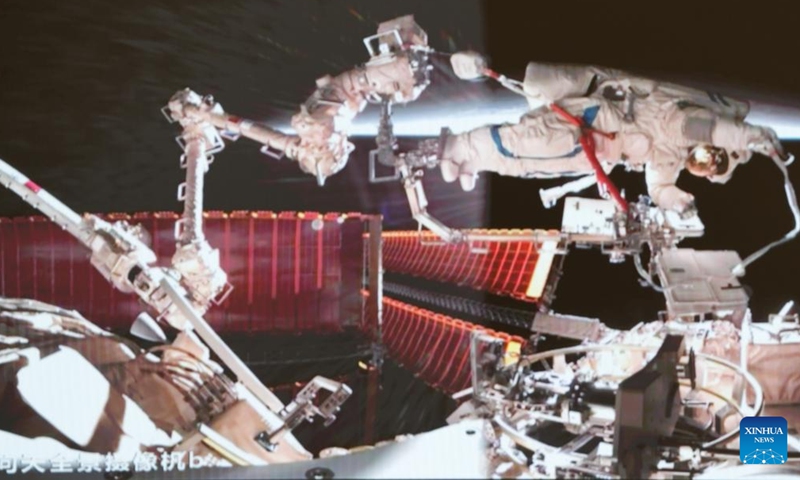Shenzhou-19 crew successfully completes second series of extravehicular activities

Taikonauts of the Shenzhou-19 manned spaceflight mission crew successfully completed their second series of extravehicular activities (EVAs) at 1:12 am on Tuesday, which lasted approximately 8.5 hours, the Global Times learned from the China Manned Space Agency (CMSA.) The agency also outlined plans consisting of three major missions for 2025.
The Chinese Academy of Sciences also disclosed to the Global Times on Tuesday as the China Space Station enters the third year of becoming fully operational, abundant research results have been achieved in multiple disciplines including the space biology and new materials science, laying foundations for future applications.
Cai Xuzhe, Song Lingdong and the third member of the crew Wang Haoze, collaborated to install space debris protection devices and perform an extravehicular inspection. with support from the China Space Station's robotic arm and a team on Earth, the CMSA revealed in a press release it provided to the Global Times on Tuesday.
Cai, the mission commander and Song, who performed the spacewalk duties, safely returned to the Wentian lab module, marking a full success of the mission.
The Shenzhou-19 mission is nearing its halfway point, the CMSA said, as the crew continues to conduct numerous scientific experiments and technical tests in orbit.
A few days later, despite their busy schedule, the Shenzhou-19 crew will celebrate the Chinese New Year of the Snake in space, safeguarding China's “space home” and observing the Earth illuminated by the lights of thousands of families, the CMSA said.
The China Space Station is now in its third year of full operation. Over 180 scientific and application projects have been conducted, with nearly 2 tons of experimental modules, units, and samples sent to space, while almost 100 types of experimental samples returned to Earth. A series of original scientific results have been achieved, Global Times learned from the Chinese Academy of Sciences on Tuesday.
In recent days, researchers at the Institute of Biophysics, CAS, have been analyzing recent in-orbit monitoring footage of fruit flies from the China Space Station, examining their growth, reproduction, and behavioral patterns.
The fruit fly, a small insect that feeds on fruit, is a well-established model organism with over a century of research history. On November 15, 2024, fruit flies were sent to the space station aboard the Tianzhou-8 cargo spacecraft for experiments.
Li Yan, a researcher at the Institute of Biophysics, Chinese Academy of Sciences, explained that fruit flies in space exhibit mating, reproduction, and other behaviors similar to those on Earth. However, during these behaviors, scientists have observed unique behavioral patterns that differ significantly from those on Earth.
On Earth, fruit flies crawl and fly, while in space, fruit flies display behaviors like floating and flipping upside down, the scientist told the Global Times.
Currently, advanced video processing technologies and artificial intelligence (AI) are utilized on Earth to support the analysis. CAS scientists revealed that the fruit fly research platform aboard the Chinese space station is set up with very strict conditions for temperature, humidity, lighting cycles, and gas circulation. Over two months of orbital cultivation have resulted in the fruit flies producing a third generation.
Through continuous video monitoring, researchers have gathered over 4TB of in-orbit video footage of the fruit flies. These recordings are vital for studying the growth, development, and behavioral traits of fruit flies in space, including sleep, mating, and activity patterns.
Also, research has been conducted on refractory alloys in orbit, focusing on alloy materials and multi-metal compositions that are challenging to melt under Earth's conditions, utilizing the unique containerless material experimentation environment in space. This research lays the foundation for the development of important alloy materials, such as those for future aircraft engine blades, according to the CAS.
Zhang Wei, a researcher at the Space Application Engineering and Technology Center of the CAS, said that in the field of new materials research, future research aims to develop high-entropy alloys, which are created by combining over five different metals, as well as functional crystals such as scintillation crystals and semiconductor crystals. Efforts will focus on material research and preparation in the space environment, he said.
In the field of space astronomy, China plans to deploy flagship instruments, including the Xuntian space telescope and advanced high-energy cosmic radiation detection systems.
The CMSA revealed mission logos on Monday for three pivotal projects in China's manned space program for 2025, including the launches of the crewed Shenzhou-20 and Shenzhou-21 spacecrafts, as well as the Tianzhou-9 cargo mission.
According to the CMSA, both Shenzhou-20 and Shenzhou-21 missions will feature three-member astronaut crews. Shenzhou-20 is set to dock with the radial port of the space station's core module, while Shenzhou-21 will dock with its front port.
The main tasks of the astronauts will include extravehicular activities, cargo outbound deliveries via the station's cargo airlock module, and the conducting of space science experiments and technology tests.
In the second half of 2025, China plans to launch the Tianzhou-9 cargo spacecraft from the Wenchang Space Launch Site in its southern Hainan Province. This mission will deliver astronaut supplies, propellants, and a variety of payloads necessary for station operation.